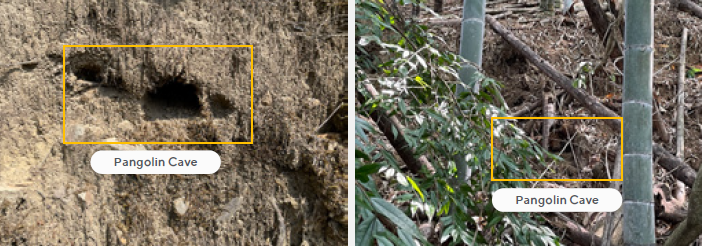In order to implement ASUS' actions to reduce environmental impact, ASUS will comply with the Forestry and Nature Conservation Agency's “Corporate Group Participation in Natural Carbon Sink and Biodiversity Matching Platform” policy starting in 2024. ASUS will work with the Kuan-Shu Education Foundation, which has a long history of environmental advocacy. The Chenglong Wetlands and Daxueshan areas are expected to be the locations for the implementation of this biodiversity project. This initiative aims to take practical steps in line with the “Kunming-Montreal Global Biodiversity Framework” to gradually reduce the negative impact on biodiversity.
Please see the news for details: ASUS Launches Biodiversity Program and Releases its First Natural Impact Assessment Report
Medium-altitude Pangolin Habitat Improvement and Conservation Project in Daxueshan
The forest farmers who cultivate the state-owned land in the Daxueshan area use a significant amount of agricultural pesticides to maintain stable crop production for fruit tree cultivation. Unfortunately, this practice has led to the destruction of the surrounding habitat. Since 2017, the Kuan-Shu Education Foundation has been invited by the Forestry and Nature Conservation Agency Bureau to cooperate in promoting grass cultivation on state-owned forest leases through friendly agricultural guidance. After conducting an on-site survey, the pilot area for the project was selected as Yucai Lane, located in the northwest of Heping District, Taichung City, on Daxueshan. The farmers accidentally discovered pangolin tracks in their orchard. They found that the habitat of these pangolins differs from previous research. However, there is currently no research on pangolin monitoring in the middle elevations. Therefore, Dr. Sun Ching-Min from the National Pingtung University of Science and Technology was invited to initiate a research project. The goal of this project is to understand whether friendly farming practices can improve the soil conditions in the area and increase the availability of food resources for pangolins, which serve as an indicator species. In the future, ASUS will continue to explore innovative technologies to facilitate biometric monitoring and exploration.

Chenglong Wetland Biodiversity Habitat Creation Project
Chenglong Wetland was originally farmland, but it has undergone significant changes over time. The area has experienced subsidence due to its low elevation and excessive groundwater extraction. In addition, seawater intrusion caused by typhoons has turned the wetland into a wasteland. The affected residents have engaged in continuous protests to voice their concerns about the impact on their livelihood. In 2005, the Forestry and Nature Conservation Agency introduced the concept of “ecological fallow” subsidies. This program provided subsidies to farmers who leased agricultural land that had become fallow. The subsidies not only supported the farmers, but also facilitated the ongoing ecological succession and natural development of the local area. In 2009, the Forestry and Nature Conservation Agency commissioned the Kuan-Shu Education Foundation to carry out the “Chenglong Wetland Community Learning and Participation Project.” The Kuan-Shu Education Foundation, through its “ Three Generations of Chenglong Wetlands “ program, focuses on the objective of “learning from the wetlands” and implements long-term community empowerment and environmental education. Through observation, the Kuan-Shu Education Foundation has found that wetlands provide favorable conditions for diverse biological survival. They have also identified unique fish species such as the Oryzias latipes. As a result, they intend to involve National Chiayi University in a project to build a biodiversity habitat. The goal is to create a more suitable environment for the survival and conservation of local species. ASUS will also conduct research projects on natural carbon sinks to support future scientific reduction efforts.


